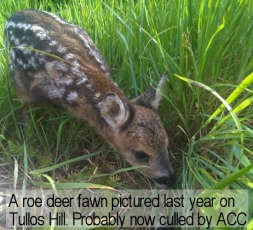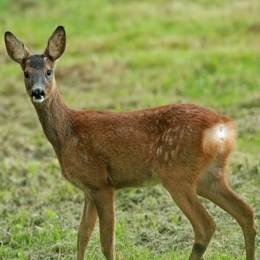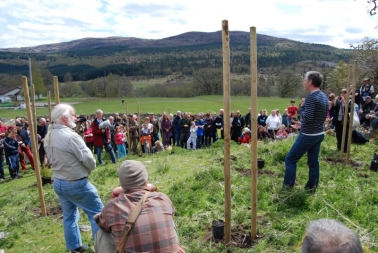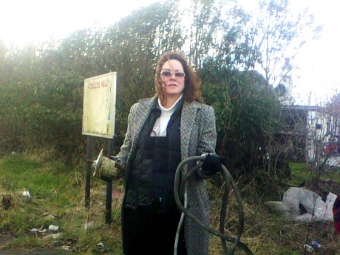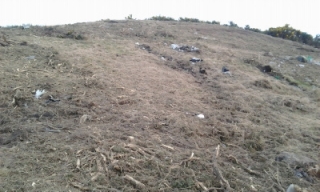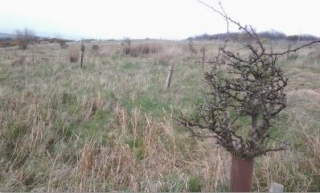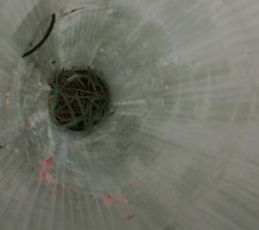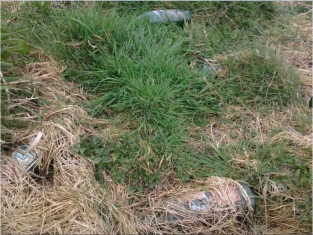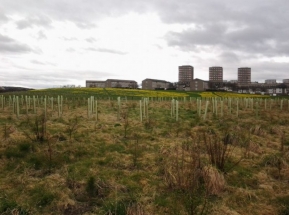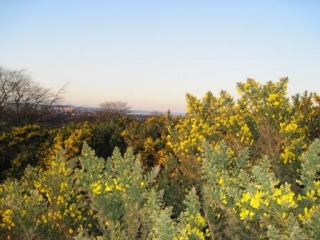34 Deer – possibly 35 – were killed from March to early May 2012. This newly emerged fact contrasts with the City’s earlier claims that 22 – then 23 animals were destroyed for the controversial ‘tree for every citizen’ scheme. Suzanne Kelly updates Voice readers.
The public’s frustration over the unwanted deer cull is past the tipping point, as contradictory information and propaganda mount up. A full impartial investigation is a necessity to ensure that no further culls happen and that those responsible for a catalogue of failures are brought to book.
What are the recent developments? What are some of the issues the cull’s proponents need to be held accountable for?
1. Thirty Four or Thirty Five Deer Were Shot
Last week the Press & Journal ran a story advising 23 deer had been killed. The revelation had been made earlier in Aberdeen Voice that 22 deer were shot according to the City weeks ago. The figure was increased by one due to a blunder. But the real truth is shocking.
Further to a Freedom of Information request, Aberdeen Voice learnt late last week that either 34 or 35 animals were shot between mid-March and 9 May. The city produced a notebook (the first page of which was 2/3 redacted) showing scrawled, incomplete notes for the destruction of 35 animals.
However, a typed list also supplied with this Freedom of Information request lists 34 deer killed.
From the weights of some of the does, it may be they were pregnant. The approximate age of the animals was not covered in these notes (only the sex), yet the City had claimed on one instance that the weights indicated the animals may have been malnourished.
Some of the notebook entries indicate that some deer were ‘clean kills’. Other entries make no such claim, yet the City’s FOI officers represented that all the kills were clean.
Is this definitely the case – the notes do not support this conclusion. It is also not clear how many rounds were used for the cull; it is also stated in the newly-released documents that 33 rounds were used to kill either 34 or 35 animals – which would have been quite a miraculous feat.
Times of shooting have also been contradicted – the city first claimed that some were shot in early morning hours. After Animal Concern Advice Line’s John Robins issued a press release saying such times would have been outwith the law, the City has tried to backtrack.
Who exactly authorised such a massive cull? Why are the notes so very sloppy and in places contradictory? Were shots taken outwith the legal time slots as the city first said? Should the deer have legally been shot at all (the Scottish SPCA has doubts, as will be shown later)?
The original cull plan, per a report written by ‘CJ Piper & Co’ jointly with Aberdeen City Council (presented to back the tree scheme to the Forestry Commission) said they would kill 22 deer in the first year of the tree scheme alone.
A single night-time count indicated 29 deer were on the hill at the time, and the City decided with Piper that 75% of the population would be exterminated that year to protect the non-existent trees.
What is this report? Who actually wrote it, and who on the Council rubber-stamped it as truth?
2. Report Riddled with Error and Bias Sealed Deer’s Fate
The report, co-written by ‘CJ Piper & Co.’ and Aberdeen City Council is misleading before the reader even opens it. This document, called ‘The Granite City Forest ‘Tree for Every Citizen’ Programme Tullos Hill Community Woodland’ dated December 2011, is a highly-biased document which ignores important issues (soil matrix, causes and cost of the previous failure).
Even its cover is of dubious veracity – it shows an unrecognisable Tullos Hill – one that is inexplicably beige and barren looking. Anyone assuming that was what the hill looked like could have been forgiven for thinking the tree scheme had some merit. When was this photo taken? Was it photo-shopped?
This 70 page report will be the subject of a separate article shortly. However, the three community councils and thousands of protestors against the cull, and the Scottish SPCA, Animal Concern Advice Line, and other recognised animal welfare organisations opposed to the cull will be interested to know that they constitute a ‘vociferous minority’ , and that objections have basically died out.
There was indeed a lull in protests – as no one knew there was a cull in progress, and we had been told the report to the Forestry Commission was in a draft stage. Unaware that action was urgently needed to counter the scheme, none was taken. However, those who wrote and who received this report could not have easily ignored the considerable media coverage.
One thing this report does do is acknowledge that the deer move around, and visit St Fitticks. This migration from Tullos, coupled with the migration to/from Kincorth, indicate that the deer were able to move around and graze at different locations over a very large area – thus the claim they could not be supported in their numbers on Tullos Hill – which they had been for decades – certainly looks like more propaganda.
The City’s claims that the law forced them to shoot deer because of the size of the acreage are discredited. If the SNH ever issued an enforcement order on Aberdeen City to shoot the deer, it has never been produced.
The trees are thought by some experts to be highly unlikely to grow in this area
Readers will be less than pleased to know ‘deer control measures’ are planned for St Fitticks. Aberdeen Voice writers and the public have photographs of the tree tubes at St Fitticks. They are virtually all intact – except where clearly vandalised by people (unless deer have taken to drinking cans of lager and smoking).
Most of the tubes on this often flooded plain adjacent to the North Sea and subject to its strong winds and salt sprays are choked with weeds. None of these trees has flourished. Photographs also show some tubes, wholly undamaged, to be completely empty. The trees are thought by some experts to be highly unlikely to grow in this area, possibly even less so than on Tullos.
How someone within the City co-wrote such an inaccurate report and submitted it to support the tree scheme without it being approved by elected officials (many of whom clearly would have objected to much of the contents) is a mystery in need of investigation.
However, how CJ Piper & Co., already paid at least £44,000 for furthering the tree scheme and which will make money from the scheme is allowed to create such a biased piece in his financial favour is potentially a matter for Audit Scotland. So much for robust internal reporting.
What have we seen in the mainstream press lately about the cull and the tree scheme? Two cases in point come to mind which will shortly be considered.
One concerns a press release from Animal Concern Advice Line, advising 23 deer were shot dead, and pointing out that the officially reported shooting times, supplied by the council, indicated that shooting took place during hours when using rifles on the hill would have been illegal.
The Press & Journal however reported that 23 deer had been shot, and the cull was necessary because of new legislation (this is still quite debatable, however often the City repeats this line). This story also dismissed one important issue in a single line, claiming there was ‘no legal requirement’ for the council to put up warning signs over the shooting going on during the evenings on Tullos Hill. Does that seem right to anyone?
3. The Shooting: Aberdeen Ignored its own Risk Register despite Lethal Risks
City officials (perhaps Pete Leonard, perhaps Ranger Ian Tallboys included) created a risk register for the cull and tree planting. Three separate issues admitted, quite obviously, that to have people shooting on the hill created a lethal risk to ‘non-target species’ (ie you and I) as well as a variety of animals. This register said warning signs were to be placed at each and every entrance to the hill to let people know there was a lethal risk.
In the end, what was the text of the signs – signs which virtually no one claims to have seen at the entrance points? A Freedom of Information Request reply insists there were warning signs on all the entrance points which read: “Warning – Forestry Operations in Progress.”
would you take your family on a hill where a person or persons were shooting powerful rifles at animals?
All the legal and animal experts are in agreement that such signs have nothing whatsoever to do with telling the public there is risk of getting shot. Regular hill visitors are compiling lists of times and dates they were on the hill – for many protestors were specifically looking for the warning signs which normally would be up in such a situation. There is photographic evidence indicating no such signs were up at entrances.
However, the point is the text used warning signs (wherever they may have been posted) were wholly inadequate, and it is only by luck some young motor-biker, pet, or other person wasn’t injured.
You might happily take your spouse and children on a hill if a man was working a digger or if people were digging holes and planting trees: but would you take your family on a hill where a person or persons were shooting powerful rifles at animals? This disregard for public safety and non-compliance with a risk register calls for an independent investigation.
How such a blatant lack of proper procedures was allowed must be examined – and all the evidence points to the cull backers wanting the public to be kept in ignorance for political reasons – even with a life-threatening risk. One missed shot, one startled hunter, one sudden movement of a startled deer and we could have had a shot off target – with a bullet travelling a quarter of a mile a distinct possibility. Someone must be brought to book, and legal action considered.
So the mainstream press went with the line that ‘warning signs were not a legal requirement’. The smallest bit of common sense dictated that they were. But this was not the only instance of the press favouring the Council’s position. In an earlier, less serious situation, Aileen Malone was quoted in the Press & Journal as claiming ‘only about one’ person in Aberdeen wrote to her objecting to the cull.
Aberdeen Voice soon documented a minimum of half a dozen people contacting her by email and including their Aberdeen postal addresses as well. Malone apologised for ‘accidentally deleting’ one such email. However, when supplied evidence contradicting their earlier story, the P&J declined to print a correction.
Here is more on a recent story its sister paper, the Evening Express, printed.
4. How and Why did a letter from the Scottish SPCA about 2 dead deer in 2010 become a 2012 story?
An Evening Express headline of 16 April 2012 read,
“Deer found dead ahead of Aberdeen’s controversial cull Animals ‘starved to death’ on tree-planting site.”
The electronic story summary online led people to believe that deer were starving at the present date, and therefore it was OK to kill the deer. And when exactly did these two deer die? 2010. Indeed, that is ‘ahead’ of the cull.
How did the letter quoted in the article between the City and the Scottish SPCA come to be released during a time it transpired the cull was covertly taking place? Who contacted the Evening Express? Why was such an old story turned into a new story, and how did the original electronic version happen to omit any reference to this story being old?
For that matter, the reason for the deer’s deaths was not actually investigated at the time according to sources.
This attempt to manipulate the press and therefore manipulate public opinion should never have happened
The City is now meant to supply the letters between themselves and the Scottish SPCA under a new FOI request.
The City is also asked to identify which person contacted the press with this letter, for it certainly was not supplied to the news by the Scottish SPCA.
The City Council’s information officers are saying there is such a volume of correspondence concerning Tullos Hill and the Deer cull with the Scottish SPCA that they cannot possibly dig out all the letters for me. The Scottish SPCA’s spokesperson has assured Aberdeen Voice this claim of a large volume of correspondence on the subject is without foundation.
This attempt to manipulate the press and therefore manipulate public opinion should never have happened. If it was done with the knowledge or involvement of a paid City employee or an elected City Councillor, then appropriate disciplinary procedures should be invoked.
Whoever at the City or with access to the City’s correspondence with the Scottish SPCA should be identified, an investigation held, and the person or persons dealt with appropriately for this ham-fisted propaganda.
5. The Scottish SPCA Told Pete Leonard Why The Cull Was Wrong (and possibly illegal)
One Scottish SPCA letter, this time not from two years ago like the letter leaked to the Evening Express, sums up some of the key points against the cull quite nicely.
A letter of 28 March 2012 (when sadly about one dozen deer were already killed) informs the city that Scotland’s Animal welfare charity, the Scottish SPCA, is still very much against the cull ‘unless there are genuine animal welfare or public safety concerns which justify such action. We do not believe that such concerns exist in this case.’ The letter also said:-
“We are sure you are aware that the licence to shoot deer out of season can only be granted under the Deer (Scotland) Act 1996… to prevent serious damage to unenclosed woodland. As no woodland currently exists, we would not expect the Council to be in a position to legally conduct such a cull at present.”
At the alarmed animal welfare groups’ advice, this blatant blackmail was rejected
The city says again and again it is obliged to shoot the deer for population reasons due to new legislation – even though it is fully understood by both sides the deer are moving across at least three areas – therefore making the city’s claim that Tullos Hill isn’t big enough to support the deer a nonsense.
The fact the deer have lived on the hill – sorry HAD lived on the hill for some 70 years without massive population explosion issues. The bottom line is this Scottish SPCA letter says
“…we are not aware of any existing welfare concerns for the current herd of approximately thirty roe deer that inhabit Tullos Hill and have done so for many years.”
Those who have followed this sorry saga for the past year will recall the city’s blackmail bid to get the public to come up with £225,000 in order to save the deer. At the alarmed animal welfare groups’ advice, this blatant blackmail was rejected. (What kind of precedent would have been set?)
The city again changed tack, and said even if the public did pay, they would still shoot deer for the nonexistent trees (which as per earlier reports will somehow grow in poor soil on one of the windiest spots in the city – where they have failed to grow before).
Why was the public meant to come up with the arbitrary sum of £225,000 in less than two months? It was to be used for fencing and other deer-proofing measures. However, the use of tree guards was discounted by an ACC person named ‘Richard’ and the SNH – because tree guards have ‘visual impact’.
We were supposed to surrender a quarter of a million pounds to save our deer so the scheme to plant ‘a tree for every citizen’ could remain the ‘cost neutral’ scheme that Councillor Aileen Malone and others maintained it was. The main selling feature of the tree scheme was that it would not cost us a penny. In fact, a FOI request asking about why the scheme had to be adhered to earned the reply:
“Creating these woodlands close to urban areas will deliver on all these points, with the additional benefit of being created at no cost to the City Council due to the levels of external funding being obtained to deliver the project. This demonstrates that the Tree for Every Citizen is not taking resources from other services within the City.”
The fact of the matter is this scheme has cost you and I a great deal so far…
6. £167,000 Cost of Killing Deer and Planting Trees – Minimum Cost to Date
The FOI assurance that the scheme will not cost any money and that corporate sponsors will fund it in part has not exactly proved to be accurate. Firstly, and for obvious reasons, few businesses could be found to pay for the killing of a beloved herd of nearly tame deer.
Magically, the fences which the public were initially asked to pay for to save the deer have been erected, both permanent and temporary ones (indeed, the only ‘forestry operations’ sign the author ever saw was on a temporary enclosure deep within the hill – which would have been of little warning to anyone getting that deep into the land). Also, the tree guards suddenly lost their ‘visual impact’ and can be seen on the few trees planted to date.
Much of the gorse which homed and fed a variety of creatures has been cleared, and the hill today now resembles the barren photograph taken months earlier. Leaving aside the pollution, waste and soil matrix of this cleared area, we the taxpayer have paid £480 per week to clear this land.
As the bookkeepers managed to ignore the £43,800 – what else has been omitted?
The city won’t tell you who or which company did this work – even though the contractor was paid with public funds. The city says they should not be identified.
The information Commissioner may well have different ideas.
Subtracting the £43,800 which the city had to return for the phase one planting failure, then we have spent a minimum of £167,000 to date. However, it is not clear that all the cost are recorded on the sheet. As the bookkeepers managed to ignore the £43,800 – what else has been omitted?
One glaring omission is one of the few items showing funds coming in: many of the dead deer carcasses were sold to a ‘licensed game dealer’. The city will be asked to disclose how much revenue it received for destroying these 34 or 35 deer.
Readers might like to know that ‘CJ Piper & Co’ is not a company listed with Companies House. There is however well-known forestry agent Chris Piper. The city claim not to have any details for CJ Piper & Co – despite naming this entity as a payee for c. £44,000 on the spreadsheet of expenses and income for the scheme, and despite writing a paper jointly with it.
Finally, we do not yet know what type of herbicides the scheme’s supporters plan to spray over the hill for the next few years or what the cost will be. There seems to be no budget provision for this, and it is unclear that local residents, school authorities and industry have been asked for their consent.
7. Enough is Enough: Recommendations
This catalogue of bad decisions, fiscal irresponsibility, constantly changing stories, withheld information, expense, and not least destruction of a deer herd while risking peoples’ lives has gone far enough. There must be no cull again. The tree scheme should be investigated from inception to current day by wholly independent soil and tree experts (we know the soil is extremely poor for a variety of reasons). The finances and the empty promise of a ‘cost neutral’ scheme likewise need to be gone over by independent experts.
It is very easy to identify the drivers of this scheme; they are Aileen Malone (former convener of the Housing & Environment Committee), Pete Leonard, Director of Housing, and Ranger Ian Tallboys. In order to further this scheme, the public has been misled over finances, fed propaganda on deer welfare, blackmailed for funds, and had their safety compromised over several months while shooting was in progress.
The Information Commissioner will be asked to look into some of the FOI discrepancies
Audit Scotland should be asked to examine the finances, the manner in which consultants and contractors were selected, and whether CJ Piper should or should not have been involved in co-authoring a report when there was a clear financial interest for them in the report’s contents.
The Information Commissioner will be asked to look into some of the FOI discrepancies. This the author will see to shortly. To those in positions of power – and to citizens who can contact their elected representatives I would suggest calling for the following:-
The relevant internal and external audit/risk bodies should launch investigations. Audit Scotland should look at the finances, and ACC’s Risk / Audit Committee should have an enquiry.
We are talking about an unnecessary risk to public safety, and those responsible should now resign their posts and apologise to the public without further delay.
The Standards Commission and the City’s Audit & Risk Committee should likewise examine the scheme from start to the current date to evaluate the conduct of those who were involved in supporting the scheme.
All further culls should be called off. Plans to spray herbicides for years need to be halted or at the least scrutinised and presented to the public who live and work in the area.
If there is a case to be made for prosecutions over these issues (not least the risk register being ignored), then the legal authorities should be made to investigate.
If the trees can grow without further culls, fine. If trees cannot (and remember the main culprits were weeds and soil for the previous failure – there is far more evidence of these factors than for deer browsing), then it is time for Councillor Cooney’s proposal for Tullos to be a meadowland (gently enhanced rather than having its ecosystem further eradicated) should be resurrected. It mysteriously was shot down in part due to Pete Leonard’s position on the meadowland scheme.
Crucially, we must allow this herd to grow again – if it can.
Finally, lessons must be learnt. the Scottish SPCA and other animal welfare entities, Community Councils and the public must never receive such shoddy treatment ever again.
- Comments enabled – see comments box below. Note, all comments will be moderated.

